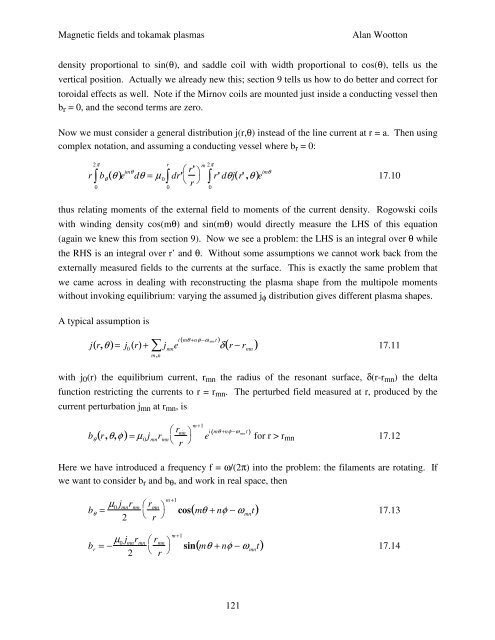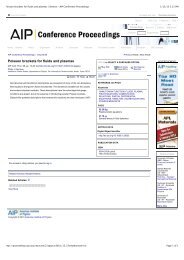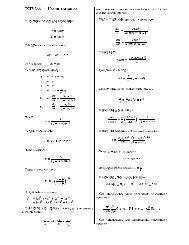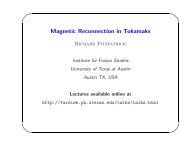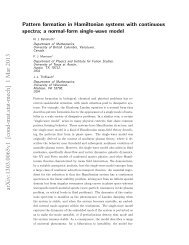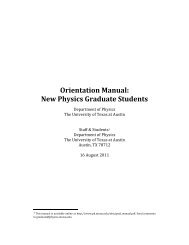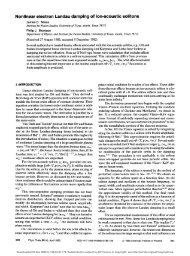Magnetic Fields and Magnetic Diagnostics for Tokamak Plasmas
Magnetic Fields and Magnetic Diagnostics for Tokamak Plasmas
Magnetic Fields and Magnetic Diagnostics for Tokamak Plasmas
Create successful ePaper yourself
Turn your PDF publications into a flip-book with our unique Google optimized e-Paper software.
<strong>Magnetic</strong> fields <strong>and</strong> tokamak plasmas<br />
Alan Wootton<br />
density proportional to sin(θ), <strong>and</strong> saddle coil with width proportional to cos(θ), tells us the<br />
vertical position. Actually we already new this; section 9 tells us how to do better <strong>and</strong> correct <strong>for</strong><br />
toroidal effects as well. Note if the Mirnov coils are mounted just inside a conducting vessel then<br />
b r = 0, <strong>and</strong> the second terms are zero.<br />
Now we must consider a general distribution j(r,θ) instead of the line current at r = a. Then using<br />
complex notation, <strong>and</strong> assuming a conducting vessel where b r = 0:<br />
2π<br />
r ∫ b θ<br />
( θ ) e imθ ⎛<br />
dθ = µ 0 ∫ dr'<br />
⎝<br />
0<br />
r<br />
0<br />
r'<br />
r<br />
⎞<br />
⎠<br />
m 2π<br />
∫ r' dθj( r' ,θ ) e imθ 17.10<br />
0<br />
thus relating moments of the external field to moments of the current density. Rogowski coils<br />
with winding density cos(mθ) <strong>and</strong> sin(mθ) would directly measure the LHS of this equation<br />
(again we knew this from section 9). Now we see a problem: the LHS is an integral over θ while<br />
the RHS is an integral over r’ <strong>and</strong> θ. Without some assumptions we cannot work back from the<br />
externally measured fields to the currents at the surface. This is exactly the same problem that<br />
we came across in dealing with reconstructing the plasma shape from the multipole moments<br />
without invoking equilibrium: varying the assumed j φ distribution gives different plasma shapes.<br />
A typical assumption is<br />
∑<br />
j( r,θ)= j 0<br />
( r) + j mn<br />
e<br />
m ,n<br />
( )<br />
δ r − rmn<br />
i mθ +nφ −ω mnt<br />
( ) 17.11<br />
with j 0 (r) the equilibrium current, r mn the radius of the resonant surface, δ(r-r mn ) the delta<br />
function restricting the currents to r = r mn . The perturbed field measured at r, produced by the<br />
current perturbation j mn at r mn , is<br />
b θ<br />
m +1<br />
⎛ r<br />
( r,θ,φ) = µ 0<br />
j mn<br />
r mn ⎞<br />
mn<br />
⎝ r ⎠<br />
e i( mθ +nφ −ω mn t)<br />
<strong>for</strong> r > r mn 17.12<br />
Here we have introduced a frequency f = ω/(2π) into the problem: the filaments are rotating. If<br />
we want to consider b r <strong>and</strong> b θ , <strong>and</strong> work in real space, then<br />
b θ<br />
= µ 0<br />
j mn<br />
r mn<br />
2<br />
b r<br />
= − µ 0<br />
j mn<br />
r mn<br />
2<br />
⎛ r mn<br />
⎝ r<br />
⎛ r mn<br />
⎝ r<br />
m +1<br />
⎞<br />
⎠<br />
cos( mθ + nφ − ω mn<br />
t) 17.13<br />
m +1<br />
⎞<br />
⎠<br />
sin( mθ + nφ − ω mn<br />
t) 17.14<br />
121


